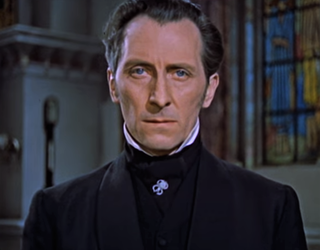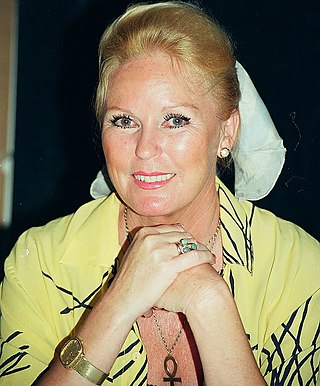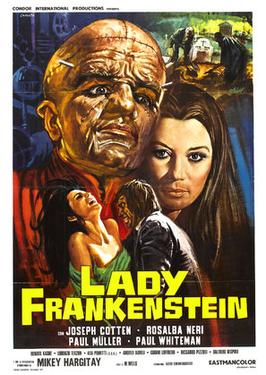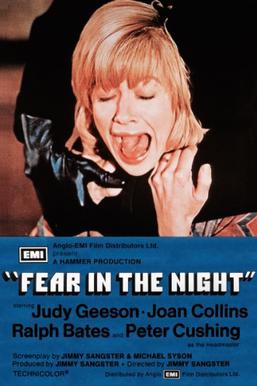
Peter Wilton Cushing was an English actor. His acting career spanned over six decades and included appearances in more than 100 films, as well as many television, stage and radio roles. He achieved recognition for his leading performances in the Hammer Productions horror films from the 1950s to 1970s, and as Grand Moff Tarkin in Star Wars (1977).
Hammer Film Productions Ltd. is a British film production company based in London. Founded in 1934, the company is best known for a series of Gothic horror and fantasy films made from the mid-1950s until the 1970s. Many of these involve classic horror characters such as Baron Victor Frankenstein, Count Dracula, and the Mummy, which Hammer reintroduced to audiences by filming them in vivid colour for the first time. Hammer also produced science fiction, thrillers, film noir and comedies, as well as, in later years, television series.

Dracula is a 1958 British gothic horror film directed by Terence Fisher and written by Jimmy Sangster based on Bram Stoker's 1897 novel of the same name. The first in the series of Hammer Horror films starring Christopher Lee as Count Dracula, the film also features Peter Cushing as Doctor Van Helsing, along with Michael Gough, Melissa Stribling, Carol Marsh, and John Van Eyssen. In the United States, the film was retitled Horror of Dracula to avoid confusion with the U.S. original by Universal Pictures, 1931's Dracula.

Terence Fisher was a British film director best known for his work for Hammer Films.

The Curse of Frankenstein is a 1957 British horror film by Hammer Film Productions, loosely based on the 1818 novel Frankenstein; or, The Modern Prometheus by Mary Shelley. It was Hammer's first colour horror film, and the first of their Frankenstein series. Its worldwide success led to several sequels, and it was also followed by new versions of Dracula (1958) and The Mummy (1959), establishing "Hammer Horror" as a distinctive brand of Gothic cinema.

James Henry Kinmel Sangster was a British screenwriter and director, most famous for his work on the initial horror films made by the British company Hammer Films, including The Curse of Frankenstein (1957) and Dracula (1958).

Veronica Carlson was a British actress and model who was known for her roles in Hammer horror films. In 2019, she was inducted into the Rondo Hatton Classic Horror Awards' Monster Kid Hall of Fame.

Frankenstein Must Be Destroyed is a 1969 British horror film directed by Terence Fisher for Hammer Films, starring Peter Cushing, Freddie Jones, Veronica Carlson and Simon Ward. The film is the fifth in a series of Hammer films focusing on Baron Frankenstein, who, in this entry, terrorises those around him in a bid to uncover the secrets of a former associate confined to a lunatic asylum.

The Evil of Frankenstein is a 1964 film directed by Freddie Francis. The third instalment in Hammer's Frankenstein series, it stars Peter Cushing, Sandor Elès and Kiwi Kingston.

The Brides of Dracula is a 1960 British supernatural horror film produced by Hammer Film Productions. Directed by Terence Fisher, the film stars Peter Cushing, David Peel, Freda Jackson, Yvonne Monlaur, Andrée Melly, and Martita Hunt. The film is a sequel to the 1958 film Dracula, though the character of Count Dracula does not appear in the film, and is instead mentioned only twice. Christopher Lee would reprise his role as Dracula in the next film in the Dracula series, Dracula: Prince of Darkness (1966).

Frankenstein Created Woman is a 1967 British Hammer horror film directed by Terence Fisher. It stars Peter Cushing as Baron Frankenstein and Susan Denberg as his new creation. It is the fourth film in Hammer's Frankenstein series.

Lady Frankenstein is a 1971 Italian horror film directed by Mel Welles and written by Edward di Lorenzo. It stars Rosalba Neri, Joseph Cotten, Mickey Hargitay and Paul Müller.

Frankenstein and the Monster From Hell is a 1974 British horror film, directed by Terence Fisher and produced by Hammer Film Productions. It stars Peter Cushing, Shane Briant and David Prowse. Filmed at Elstree Studios in 1972 but not released until 1974, it was the final chapter in the Hammer Frankenstein saga of films as well as director Fisher's last film.

Lust for a Vampire, also known as Love for a Vampire or To Love a Vampire, is a 1971 British Hammer Horror film directed by Jimmy Sangster, starring Ralph Bates, Barbara Jefford, Suzanna Leigh, Michael Johnson, and Yutte Stensgaard. It was given an R rating in the United States for some violence, gore, strong adult content and nudity. It is the second film in the Karnstein Trilogy, loosely based on the 1872 Sheridan Le Fanu novella Carmilla. It was preceded by The Vampire Lovers (1970) and followed by Twins of Evil (1971). The three films do not form a chronological development, but use the Karnstein family as the source of the vampiric threat and were somewhat daring for the time in explicitly depicting lesbian themes.

The Revenge of Frankenstein is a 1958 Technicolor British horror film directed by Terence Fisher and starring Peter Cushing, Francis Matthews, Michael Gwynn and Eunice Gayson. Made by Hammer Film Productions, the film was a sequel to The Curse of Frankenstein, the studio's 1957 adaptation of Mary Shelley's 1818 novel Frankenstein; or, The Modern Prometheus, and the second instalment in their Frankenstein series.

Fear in the Night is a 1972 British psychological horror film directed, produced, and co-written by Jimmy Sangster and produced by Hammer Film Productions. The film stars Judy Geeson as a psychologically-fragile woman who, upon relocating to a rural boarding school where her husband has taken a job, finds herself being tormented by a mysterious figure with a prosthetic arm. Peter Cushing and Joan Collins, respectively, also star as the school's mysterious headmaster and his wife.
A History of Horror is a 2010 three-part documentary series made for the BBC by British writer and actor Mark Gatiss. It is a personal exploration of the history of horror film, inspired by Gatiss's lifelong enthusiasm for the genre.

Tales of Frankenstein is an unsold TV pilot filmed in 1958. It was a co-production of Hammer Film Productions and Columbia Pictures. The film is a mixture of elements from both the Hammer and Universal Pictures versions of Frankenstein, based on Mary Shelley's 1818 novel Frankenstein; or, The Modern Prometheus. The episode title, which does not appear onscreen, is "The Face in the Tombstone Mirror". The film is in the public domain.
Frankenstein is a British horror-adventure film series produced by Hammer Film Productions. The films, loosely based on the 1818 novel Frankenstein; or, The Modern Prometheus by Mary Shelley, are centered on Baron Victor Frankenstein, who experiments in creating a creature beyond human. The series is part of the larger Hammer horror oeuvre.
The World of Hammer is a British television documentary series created and written by Robert Sidaway and Ashley Sidaway, and produced by Robert Sidaway.
















